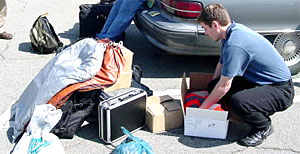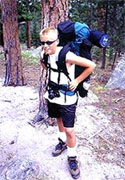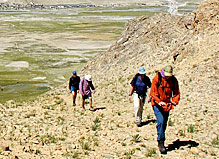What To Pack :
 Figuring out what to pack is not easy, but do remember the principle: Pack minimum!
What to PackWhat type of clothing you bring depends on which part of Tibet you go. But remember casual attire is the style. Warm clothing is a must to ensure a smooth tour since you are supposed to meet unexpected bad weather as well as temperature extremes in Tibet. Layered clothing which can be easily added or removed is the choice since temperature may vary greatly within a single day. Down coat is necessary for those who would like to go beyond Lhasa and Shigatse to remote areas, the Everest Camp for example. A windbreaker plus a sweater can be just okay if you just walk around Lhasa in summer. During the peak tourism season, frequent rainfall makes waterproof clothing and raincoat a preference. Other recommended clothing includes four or five pairs of cotton or woolen underwear, four or five pairs of woolen socks, long sleeve shirts and T-shirts. Women shall avoid skirts. Comfortable and stout sneaker is also recommended. Bring your mitten or glove and hat also.
Figuring out what to pack is not easy, but do remember the principle: Pack minimum!
What to PackWhat type of clothing you bring depends on which part of Tibet you go. But remember casual attire is the style. Warm clothing is a must to ensure a smooth tour since you are supposed to meet unexpected bad weather as well as temperature extremes in Tibet. Layered clothing which can be easily added or removed is the choice since temperature may vary greatly within a single day. Down coat is necessary for those who would like to go beyond Lhasa and Shigatse to remote areas, the Everest Camp for example. A windbreaker plus a sweater can be just okay if you just walk around Lhasa in summer. During the peak tourism season, frequent rainfall makes waterproof clothing and raincoat a preference. Other recommended clothing includes four or five pairs of cotton or woolen underwear, four or five pairs of woolen socks, long sleeve shirts and T-shirts. Women shall avoid skirts. Comfortable and stout sneaker is also recommended. Bring your mitten or glove and hat also.
 How to PackA big backpack is not a good choice if you have no intension to trek to remote areas. A belt bag or alike shall be brought for the safety of important certificates and travel documents. Pack maps, money, toilet items, tissues, plastic bags, shaver, flashlight, battery, sewing kit, lighter, knife as well as your camera and films. Sunscreen, sun block, sunglasses and lip balm are essential to protect you from sun burn. Better bring a lock with you since some rooms in hostels in remote areas do not have a lock. Candles may be useful in hostels in remote areas. Don't forget to bring some pencils, candies and other little presents for local children and people so you can have a close contact with local people.
How to PackA big backpack is not a good choice if you have no intension to trek to remote areas. A belt bag or alike shall be brought for the safety of important certificates and travel documents. Pack maps, money, toilet items, tissues, plastic bags, shaver, flashlight, battery, sewing kit, lighter, knife as well as your camera and films. Sunscreen, sun block, sunglasses and lip balm are essential to protect you from sun burn. Better bring a lock with you since some rooms in hostels in remote areas do not have a lock. Candles may be useful in hostels in remote areas. Don't forget to bring some pencils, candies and other little presents for local children and people so you can have a close contact with local people.
Mountain Sickness :
 Generally altitude over 3,000 meters (9,843 feet) is defined as high altitude. Since most places in Tibet are higher than that level, Acute Mountain Sickness (AMS), also called Altitude Sickness is the biggest health threat to tourists in Tibet. AMS is common at high altitudes due to the decreasing availability of oxygen. It is usual that most people will experience symptoms at different levels at that high elevation. The occurrence of AMS is dependent on the altitude, the ascent rate and individual physical condition. Symptoms of AMS include headache, nausea, Mountain Sicknessdizziness, fatigue, shortness of breath, loss of appetite and disturbed sleep. Many people will experience one or more AMS symptoms upon their arrival in Tibet. The symptoms will usually decrease in severity gradually during the acclimatization. Mild AMS is usual and will not interfere with mild activity.
However AMS can be very serious. The most serious symptoms are High Altitude Pulmonary Edema (HAPE) and High Altitude Cerebral Edema (HACE), which can be fatal. Symptoms of HAPE include weakness, shortness of breath, even at rest, impending suffocation at night, and a persistent productive cough with white, watery, or frothy fluid. Symptoms of HPCE may include headache, ataxia, weakness, hallucinations, psychotic behavior, coma and loss of memory. Both approach and strike at night and can be fatal! Immediate descent is the surest treatment.
Generally altitude over 3,000 meters (9,843 feet) is defined as high altitude. Since most places in Tibet are higher than that level, Acute Mountain Sickness (AMS), also called Altitude Sickness is the biggest health threat to tourists in Tibet. AMS is common at high altitudes due to the decreasing availability of oxygen. It is usual that most people will experience symptoms at different levels at that high elevation. The occurrence of AMS is dependent on the altitude, the ascent rate and individual physical condition. Symptoms of AMS include headache, nausea, Mountain Sicknessdizziness, fatigue, shortness of breath, loss of appetite and disturbed sleep. Many people will experience one or more AMS symptoms upon their arrival in Tibet. The symptoms will usually decrease in severity gradually during the acclimatization. Mild AMS is usual and will not interfere with mild activity.
However AMS can be very serious. The most serious symptoms are High Altitude Pulmonary Edema (HAPE) and High Altitude Cerebral Edema (HACE), which can be fatal. Symptoms of HAPE include weakness, shortness of breath, even at rest, impending suffocation at night, and a persistent productive cough with white, watery, or frothy fluid. Symptoms of HPCE may include headache, ataxia, weakness, hallucinations, psychotic behavior, coma and loss of memory. Both approach and strike at night and can be fatal! Immediate descent is the surest treatment.
Before visit to Tibet, get as fit and healthy as possible, both physically and psychologically. Visitors having record of heart, lungs and other organ problems or anemia should consult their doctor before making the decision to visit Tibet.
AMS can be lessened or avoided. Proper acclimatization can also ease and reduce AMS symptoms. A gradual ascent will allow your body to acclimatize to higher altitudes and the decreased oxygen supply. Go higher 300 - 400 hundred meters (984 - 1,312 feet) daily and have a rest after every 1,000 meter (3280 feet) ascent. Medication also helps to prevent AMS. Mild AMS symptoms can be cured with proper medication. Once medications do not respond to the symptoms, go to hospital or evacuate immediately to safe altitude! The following precautions may help to keep AMS away from you: Since fluid loss usually accompanies the acclimatization process, drink plenty of fluids (3 - 4 litres daily at least) and eat carbohydrate food to maintain properly hydrated; Do not over exert and maintain light activity right after your arrival.
Stay way from smoking and alcohol and other depressants such as tranquilizers and sleeping pills, which will depress the respiratory drive and oxygen intake. Always keep in mind the following rules which may ensure you a smooth and enjoyable trip to Tibet: Any sickness at high altitude is AMS until proven otherwise; Never go higher with symptoms of AMS; It is significant that you report any symptoms of AMS immediately to other group members in the trip.
Meals & Camps :
Traditional Tibetan food consists mainly of barley, meat and dairy products. Vegetables are scarce in the high altitude. Tsampa is the staple food of Tibetan people, which is consumed daily. Tsampa is actually barley flour made from parched barley, un-husked and ground into fine flour. Mix the flour with Camps in Tibetsalted butter tea in a bowl, rotate the bowl with the left hand and mix the food with the fingers of your right hand, rolling it into small lumps, and squeezing it into your mouth with your fingers. Other ingredients may also be added to add flavor. Tibetan people eat Tsampa at every meal, and when traveling, it is brought along as a ready made meal. The salted butter tea is an indispensable Tsampa companion. Boiled tea is poured into a long cylindrical churn along with salt and yak butter, and vigorous churning makes the ingredients well blended and ready to serve. Tibetan people drink it throughout the day. Yak butter is a very important food for Tibetans. It is separated from yak milk by hard churning, and after the butter is separated from the milk, the residue becomes sour and can be made into milk curd, which is a nice thirst quencher and can be made into a delightful milk curd pastry with bailey flour.
Yoghurt is an important dietary meal for Tibetan people. The creamy milk produced by yak cows is superb. Tibetan nomads in the eastern Tibet manufacture their yoghurt in a special process. The milk is boiled first, and after removed from the stove, some old yogurt is added in. and yogurt will form in a few hours. Yogurt has been a Tibetan food for more than 1.000 years.
Dried beef and mutton stripe is also popular food in Tibet. In the winter, beef and mutton are cut into long stripes and hung in shaded areas to be air-dried. The dried meat is crisp and tastes good, and can be eaten raw, since the cold temperature in the winter has killed bacteria during the process. Big sides of beef and mutton boiled with salt, ginger and spices are also popular food among Tibetans. They take the meat and cut them with their knives. The guests will be treated with breasts and spareribs. If you are treated with a tail of white sheep, it means that you are deemed as their guest of honor.
Blood, meat, flour and liver sausages are also favored by many Tibetans. Other food stuffs include Momo (Tibetan dumplings), Thenthuk. (Tibetan noodles), and yak tongue.
At present time, in many Tibetan towns, in Lhasa for example, Tibetan food is supplemented by Chinese food, mostly Sichuan food. Vegetables and fish become available in market. However, Tibetan people seldom eat fish due to their religion and custom. Restaurants serve Tibetan, Chinese, and even western food, mushroom in the streets to accommodate tourists. In Lhasa Hotel (formerly Holiday Inn), the restaurant provides Chinese, Indian, Nepalese and western food. Kailash, Tashi, Snow Lands, Dunya (former Crazy Yak), and Makye Ame are popular among Travelers in Lhasa. The choice for vegetables will be limited due to the short agricultural season.
Tibetans like drinking tea. Besides salted butter tea, sweet milk tea is another popular beverage. Hot boiling black tea filtered is decanted into a churn, and then fresh milk and sugar are added. Vigorous churning turns out a light reddish white drink. There are many tea shops in Lhasa serving the sweet milk tea. Tibetan barley beer, called Chang is popular among all Tibetans. The beer is mild, slightly sweet and sour and contains little alcohol. The beverage is worth trying. Soft drinks and beer are also available in Lhasa.